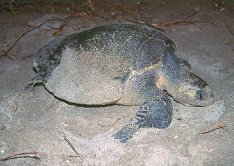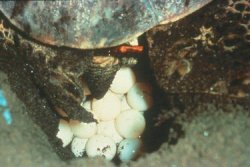NSTA Professional Development Trip: Part III
By Rob McNeely
Posted on 2012-07-27
Night 2
(posted on behalf of Greg Neff)
July 25, 8-12:00 pm
Returned to the research center for the second night shift of monitoring the turtles. It was a beautiful starry night, not a cloud in sight and comfortable temperatures. This is going to be a breeze compared to last night! This time our crew was assigned to the parquet beach which goes south from the research station. The tide was low, an unwelcome sight for the turtles as they prefer high tides as they have less crawling to do on land to reach a suitable nesting area.
Because of the low tide we had a long way to walk before we saw fresh turtle tracks. When we did discover trackside, it was like a highway, with multiple tracks crisscrossing each other. Very confusing to the novice, but the research assistants and our guides were very competent in distinguishing tracks which were fresh and had no return path.

In the earlier sift we discovered one of the challenges of preservation and sustainability. During the hours of 8:00-12:00 local guides are allowed to bring groups of tourists onto the beach to observe the turtle nesting. Groups are restricted to 10 observers or less.
Our first 2 turtles this evening, each had 4 groups waiting to see the turtle. We did our measuring tasks, being celebrities for the tourists. It was an educational experience for us as well as the tourists and a very vivid reminder that protecting and exploitation run a fine line.
We saw several turtles trying to leave the water, but nervous about the activity on land, and observed 2 returning to the sea from the nesting sites. Because of the low tide and no rain conditions, we were able to easily walk to the limits of the beach. Then we turned around and began our return to the research center. In our walk back we found 2 more turtles that were ready to be logged.

One of these was totally entwined in beach vines. This and being in the later stages of nesting cause this turtle to be more agitated than our previous charges. This turtle was throwing great quantities of sand and rolling around, making the carapace measurement a challenge. After completing the log, we were all covered with sand and sand flies.
Next 15 minutes were very uneventful, but we realized that our shift was almost over and we needed to pick up our pace dramatically in order to be back and allow the second shift to work. Then it happened the lovely stray skies disappeared and the rain immediately became torrential. Barely had time to cover the data collection kit-pack with the poncho! The last 1/2 hour was in this deluge and we had no more turtles to monitor. Half hour wait at the research station for our boat-taxi to come and return us to the Evergreen lodge. Another shower with all adds my clothes on, to remove the sand, but this time I was able to hang it all up and craw into bed by 1:00. 6 whole hours before breakfast and night 2 is done!
Tomorrow we explore the canals around Tortuguera. The canals were built by the lumber companies in order to facilitate access to remote trees and connect the rivers in the area. The lumber company was able to convince the CostaRican government that the canals would be a good idea because it would give the population better access to and from the coast. This was pare-national park days. Today the project would not be allowed as the canals dissect the national park.
Pictures are not allowed on the turtle walk. The turtle images above are from the Sea Turtle Conservancy’s web site http://www.conserveturtles.org
Disclaimer: The views expressed in this blog post are those of the author(s) and do not necessarily reflect the official position of the National Science Teaching Association (NSTA).


